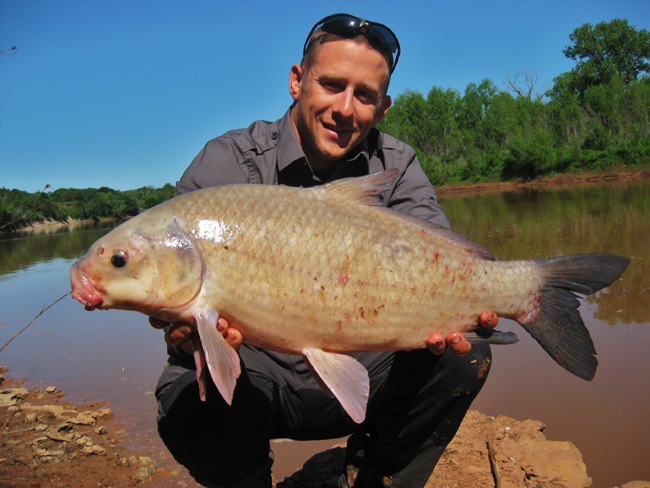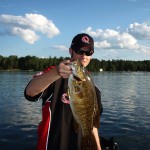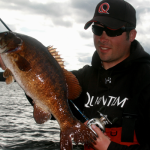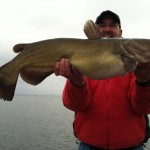By: David Graham – Date Posted: May 11, 2012
A new career opportunity lead to my recent relocation from coastal South Carolina to the hot, spacious terrain of South Texas. This ‘westward trek’ rekindled childhood memories of fishing the local creeks of northeast Oklahoma and southwest Arkansas with my brothers and Dad.
The 20+ hour drive to Corpus Christi – in a rental van jammed with scant furnishings but as much fishing gear as it would hold – I had ample time to ponder the bountiful variety of Texas-sized freshwater oddities awaiting me. Smallmouth Buffalo were of particular interest, since this is a fish I enjoyed catching during my early adolescence in Arkansas.
It is a strange paradox that some of North America’s toughest, largest fighting fish are frequently the least popular among many anglers. American anglers typically count the best freshwater ‘big fish’ to be musky, pike, large catfish, sturgeon, or even the mysterious alligator gar. One fish species – the North American Buffalo – has largely failed to escape the shadow of obscurity, despite its propensity to exceed 70-plus pounds.
The hardy North American Buffalo species has, for the most part, been cast aside as little more than worthless, bottom-feeding carp. There are several species of Buffalo, including the Smallmouth, Bigmouth, and the Black Buffalo.
Buffalo are a robust species of large-scaled suckerfish with a body structure similar to common carp. Buffalo and carp have long been confused or categorized together by anglers. Buffalo, however, are a North American native fish which has simply grown to resemble its non-native twin as a result of convergent evolution. The two species are not related.
There are several fundamental differences between Buffalo and Carp, the key one being that the Buffalo lack barbels (whiskers, to some). Common carp, while resembling Buffalo, sport definitive barbells. Additionally, Buffalo are generally a bluish-grey or tea color with large scales and a prominent lateral line. They never present the bronzy gold or yellow color of a common carp. Buffalo always have a dark, bluish colored caudal fin unlike common carp which sport the orange colored tails. Buffalo – smallmouth in particular – have much more dramatic, downturned ‘sucker-like’ mouths than the common carp, and also possess large, dark, saucer-like eyes.
The most abundant variation of the buffalo species is probably the smallmouth, which are prevalent in many Midwest rivers and lakes. They can be bound in the larger tributaries of the Mississippi, as far West as Montana and as far East as West Virginia. The species can also be found in the Gulf slope drainages from Texas to Alabama and just about everywhere in between.
Anglers in pursuit of buffalo should focus on larger pools, or depressions in larger rivers with low but steady current flow. Buffalo prefer a habitat with abundant aquatic vegetation, or gravel-rock bottom areas where they can easily forage for their primary diet of small crustaceans and larvae. Buffalo are primarily bottom feeders, hence their primary diet is insect larvae, algae, and detritus which they ‘vacuum’ off the bottom, beneath gravel and out of aquatic weeds.
Smallmouth Buffalo can and have grown as large as 100 pounds. This presents a particular challenge to anglers trying to land this strong, broad-shouldered fish that also happens to have peculiarly delicate, fleshy lips. Buffalo and Common Carp have similar feeding habits and can be caught on basically the same type of equipment. A simple internet search yields an abundant variety of dough bait recipes, but landing a Buffalo can be as simple as stringing a night crawler to a small J hook on a Carolina rig and drifting over a riffle.
My brother and I recently spent a few days fishing on the Red River, which splits South East Oklahoma and North East Texas. My primary goal during that trip was to capture a trophy-sized Alligator Gar. However, the prospect of pursuing Smallmouth Buffalo just made the trip better. I visited the same stretch of river in 2011 when my brother and I captured my first true specimen-sized alligator gar (6’9, 140lb). During that trip I had observed numerous Smallmouth Buffalo surfacing and cruising the shallow flats of the shoreline with their bulky backs exposed. At that time I did not have the materials to capture the fish, but several weeks ago I made it a point to pursue Smallmouth Buffalo.
Aside from the Smallmouth Buffalo’s excellent sporting quality, they make exceptionally good bait for alligator gar and are likely a primary food source for the gar exceeding 100 pounds in the Red river. Our bait of choice for these Buffalo was not elaborate, in fact it was a method I had been introduced to by Kirk Kirkland, the most well established alligator gar guide you will find. The bait we chose was formulated Creep Pellets which are actually livestock and horse feed.
We used brightly- colored rubber bands to secure our hooks to the pellets. I have always had a hunch that Buffalo likely rely more heavily on their vision and sense of smell than with the use of barbells like common carp. The Buffalo’s large eyes and nostrils are evidence enough that they possess a keen sense of smell and sight. I have no scientific evidence backing this notion, but the colored rubber bands seem to work.
The challenging aspect of capturing Buffalo on rod and reel is that, while they may exceed 70 pounds, they are very investigative in their bites. It has been my experience that a Buffalo will more often nuzzle, lip, and gently mouth a presented bait item as opposed to grabbing and making off with it. This is why maintaining a set-up of multiple rods requires keen focus and attention; even the slightest vibration of the rod tip could mean that a truly massive fish is interested in the bait.
Additionally, fishing for Buffalo is a very relaxing and leisurely activity. We basically chose a calm eddie pocket along the river’s shore where the current flow calmed, and observed several Buffalo surfacing. I set up 4 rods and placed each one – Carolina rigged with creep pellets – on bank sticks. The action was fast, and required an experienced hand to know the difference between a casual bump of the line and a legitimate bite.
Hooking a large Buffalo requires a great deal of finesse. Though these fish can grow to immense proportions, Smallmouth Buffalo have particularly small, fleshy mouths. This, in conjunction with their meticulous investigation of a bait, challenges the angler to use very small hooks that are well-concealed within the bait. Playing in a potential 40-pound fish on a J hook made for panfish requires anglers to pay vigilant attention to their line drag once the fish is hooked.

The Smallmouth Buffalo’s fighting style is unmistakable. They fight with raw power, scarcely change direction, headshake, or break the surface. They simply choose one direction and charge away, and defy the angler by presenting a steady pressure which places great strain on the line and hook if not carefully compensated for with proper drag pressure.
During my afore-mentioned Red River Trip we managed to capture several quality fish. Although they were not the big bruisers exceeding 40 pounds, they were just the right size to use as bait for a massive Alligator Gar!
Having tangled with even the smaller specimens, it is hard to grasp the fact that a fish capable of growing to nearly 100 pounds, and with such disproportionally powerful shoulders, could fall into such obscurity in the angling society. Fishing for Buffalo presents anglers with an opportunity to come face to face with one of North America’s true “monster fish”. There is truly a sense of pride in realizing these fish are NOT a non-native import, but a strictly American based species with undeniable sporting qualities.



















